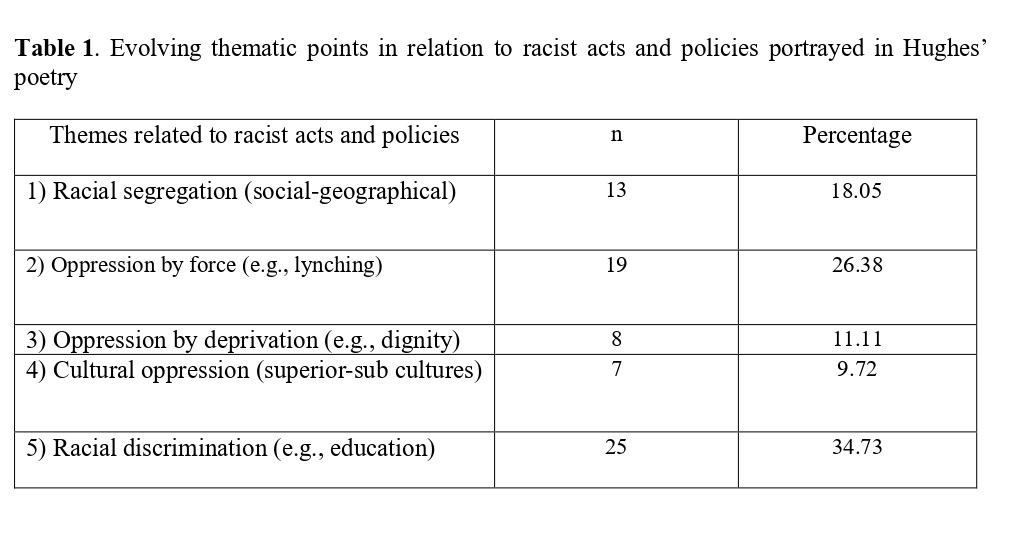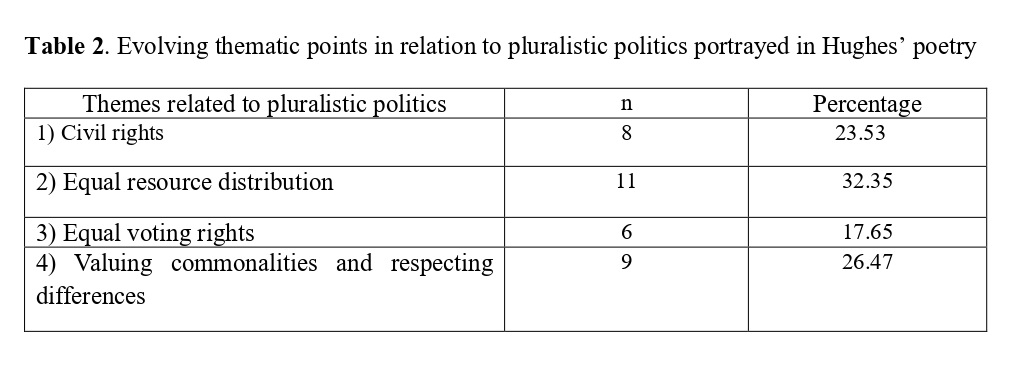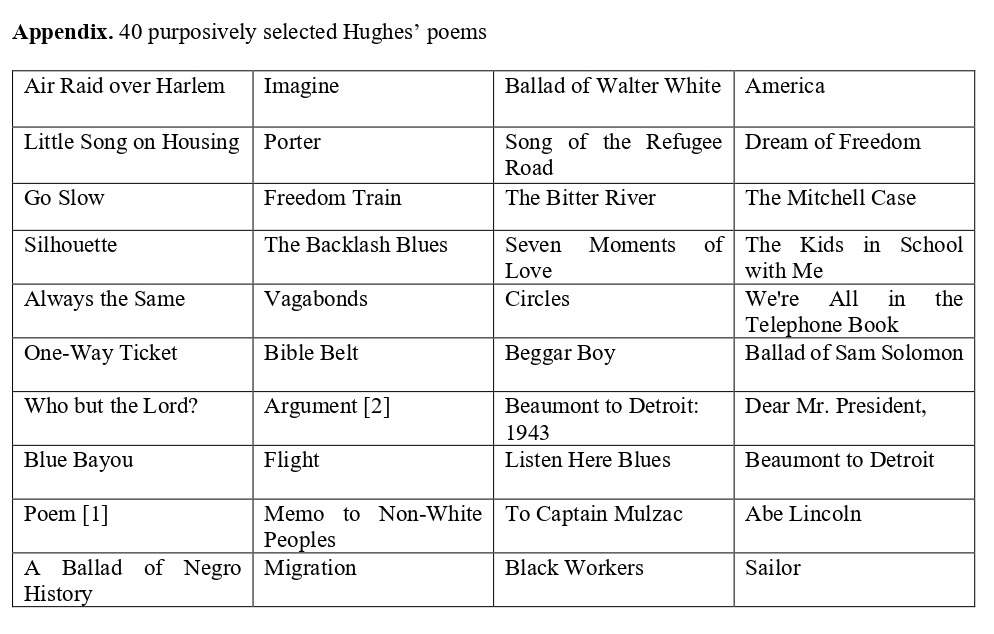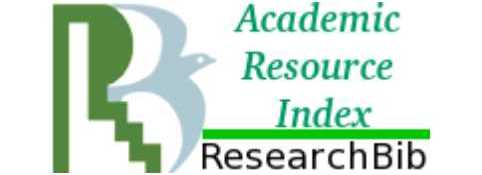Interwoven blackness and whiteness: Langston Hughes’ perspective on American pluralism
Hughes, like numerous African Americans, endured segregation, oppression, and marginalisation. In his poetry, Hughes interrogates the dire social conditions of the Black community. Hughes’ poetry not only documents the widespread racism that fosters hostile environments for black people but also explores potential remedies to this issue. This study analyses the inequitable social dynamics and power relations between whites and blacks as depicted in Hughes’ poetry and examines how the pluralistic politics expressed therein contribute to the improvement of social reality in America. This study attempts to investigate three specific questions: What creates America’s unjust social reality?What are the pluralistic politics proposed in Hughes’ poetry? And in what ways might pluralistic politics assist in enhancing the social reality in America? A dataset of 40 poems was analysed using thematic, Fairclough’s, and van Dijk’s critical discourse methodologies. The data analysis indicated that the inequitable reality depicted in Hughes’ poetry stems directly from a white-centred ideology. Beliefs in whiteness contribute to the establishment of white supremacy and perpetuation of black inferiority. These beliefs manifest in racist actions and policies. The findings reveal that Hughes’ pluralistic framework encompasses interest group pluralism, emphasising civil rights, equitable resource allocation, and equitable voting rights. This framework regards compromise as a form of negotiation. Hughes’ pluralistic politics offer insights into the creation of safe spaces within a presumably pluralistic society. This study provides a novel analysis of the power dynamics between whites and blacks as portrayed in Hughes’ poetry, offering an in-depth investigation of the pluralistic ideologies expressed within it.
Figures



Al-Ramahi, R., Ab Rashid, R., Al-Smadi, O. A. (2025). Interwoven blackness and whiteness: Langston Hughes’ perspective on American pluralism, Research Result. Theoretical and Applied Linguistics, 11 (3), 135–151.


















While nobody left any comments to this publication.
You can be first.
Allen, R. L. (2001). The globalization of White supremacy: Toward a critical discourse on the racialization of the world, Educational Theory, 51 (4), 467–485. https://doi.org/10.1111/j.1741-5446.2001.00467.x(In English)
Almahasneh, H. (2024). Identity as self-defence: Langston Hughes as the voice of the voiceless. Ars Aeterna, 16 (1), 70–83. https://doi.org/10.17846/aa-2024-16-1-70-83(In English)
Al-Ramahi, R. A., Rashid, R. A., Al-Smadi, O. A. and Ismail, H. H. (2021). The discursive strategies used by Langston Hughes in the construction of whiteness and blackness, Journal of Language and Linguistic Studies, 17 (1), 662–674. https://dx.doi.org/10.52462/jlls.45 (In English)
Bhabha, H. K. (1998). The white stuff (political aspect of whiteness), Artforum International, 36 (9), 21–23. (In English)
Biko, S. (1996). I Write What I Like: A Selection of his Writings, Ravan Press, Johannesburg. (In English)
Blommaert, J. and Blucaen, C. (2000). Critical discourse analysis, Annual Review of Anthropology, 29, 447–466. https://doi.org/10.1146/annurev.anthro.29.1.447(In English)
Boostrom, R. (1998). Safe spaces: Reflections on an educational metaphor, Journal of Curriculum Studies, 30 (4), 397–408. https://doi.org/10.1080/002202798183549(In English)
Braun, V. and Clarke, V. (2006). Using thematic analysis in psychology, Qualitative Research in Psychology, 3(2), 77-101. https://doi.org/10.1191/1478088706qp063oa(In English)
Cole, M. (2009). Critical race theory comes to the UK: A Marxist response, Ethnicities, 9 (2), 246–269. https://doi.org/10.1177/1468796809103462(In English)
Cunanan, T. B. (2011). Using transitivity as a framework in a stylistic analysis of Virginia Woolf’s Old Mrs. Grey, Asian EFL Journal, 54, 69–79. (In English)
Dahl, R. A. (1956). A Preface to Democratic Theory, University of Chicago Press, Chicago, USA. (In English)
DiAngelo, R. (2011). White fragility, International Journal of Critical Pedagogy, 3 (3), 54–70. (In English)
Dwyer, O. and Jones, J. (2000). White socio-spatial epistemology, Social & Cultural Geography, 1 (2), 209–222. https://doi.org/10.1080/14649360020010211(In English)
Efird, C. R., Wilkins, C. L. and Versey, H. S. (2024). Whiteness hurts society: How whiteness shapes mental, physical, and social health outcomes. Journal of Social Issues, 80 (1), 53–79. https://doi.org/10.1111/josi.12598(In English)
Fairclough, N. (1989). Language and Power, Longman, London, UK. (In English)
Fairclough, N. (1992). Discourse and Social Change, Polity Press, Cambridge, UK. (In English)
Fairclough, N. (1995). Critical Discourse Analysis: The Critical Study of Language, Longman, London, UK. (In English)
Fairclough, N. (1996). A reply to Henry Widdowson’s discourse analysis: A critical view, Language and Literature, 5 (1), 49–56. https://doi.org/10.1177/096394709600500105 (In English)
Fairclough, N. (2001). Language and Power, 2nd edition, Longman, Harlow. (In English)
Fairclough, N. (2006). Language and Globalization, Routledge, London, UK. (In English)
Fairclough, N. (2010). Critical Discourse Analysis: The Critical Study of Language, 2nd edition. Longman, London, UK. (In English)
Fanon, F. (1986). Black Skin, White Masks, Pluto, London, UK. (In English)
Fernández-Alonso, A. and Barros-del Río, M. A. (2021). Gender and race in Langston Hughes’ poetry of the Spanish Civil War, Journal of Gender Studies, 31 (6), 671–683. https://doi.org/10.1080/09589236.2021.1927682(In English)
Fowler, R. (1977). Linguistics and the Novel, Arrowsmith, London, UK. (In English)
Fowler, R. (1986). Linguistic Criticism, Oxford University Press, Oxford, UK. (In English)
Frankenberg, R. (1993). White Women Race Matters: The Social Construction of Whiteness, University of Minnesota Press, Minneapolis, MN, 1–22. (In English)
Gabriel, D. (2007). Layers of Blackness: Colourism in the African Diaspora, Imani Media, London, UK. (In English)
Giddens, A. (1984). The Constitution of Society: Outline of the Theory of Structuration, University of California Press, Berkeley, USA. (In English)
Giménez, R. C. (2003). Pluralismo, multiculturalismo e interculturalidad. educación future, [Pluralism, multiculturalism and intercultural education in the future], Revista de Investigación Aplicada y Experiencias Educativas, 8, 9–26.
Halliday, M. A. K. (1985). An Introduction to Functional Grammar, Edward Arnold, London, UK. (In English)
Halliday, M. A. K. (1994). An Introduction to Functional Grammar, Edward Arnold, London, UK. (In English)
Halliday, M. A. K. (2002). Linguistic Studies of Text and Discourse, Continuum International Publishing Group, London, UK. (In English)
Hanna, F. J., Talley, W. B. and Guindon, M. H. (2000). The power of perception: Toward a model of cultural oppression and liberation, Journal of Counseling & Development, 78 (4), 430–441. https://doi.org/10.1002/j.1556-6676.2000.tb01926.x(In English)
Harris, C. I. (1993). Whiteness as property, Harvard Law Review, 106, 1707–1791. (In English)
Hart, C. (2010). Critical Discourse Analysis and Cognitive Science: New Perspectives on Immigration Discourse, Palgrave MacMillan, Basingstoke. (In English)
Hatem, S. (2011). Langston Hughes: The new Negro and the integration complex, Tishreen University Journal for Research and Scientific Studies – Arts and Humanities Series, 33 (3), 207–217. (In English)
Holley, L. and Steiner, S. (2005). Safe space: Student perspectives on classroom Environment, Journal of Social Work Education, 41 (1), 49–64. https://doi.org/10.5175/JSWE.2005.200300343(In English)
Hughes, L. (1994). The Collected Poems of Langston Hughes, Random House, New York, USA. (In English)
Johnson, P. (2003). Appropriating Blackness: Performance and the Politics of Authenticity, Duke University Press, USA. (In English)
Jablonski, N. G. (2021). Skin color and race, American Journal of Biological Anthropology, 175 (2), 437–447. https://doi.org/10.1002/ajpa.24200(In English)
Jungkunz, V. (2011). Dismantling whiteness: Silent yielding and the potentiality of political suicide, Contemporary Political Theory, 10 (1), 3–20. https://doi.org/10.1057/cpt.2009.44(In English)
Karp, I. (1986). Agency and social theory: A review of Anthony Giddens, Journal of the American Ethnological Society, 13 (1), 131–137. https://doi.org/10.1525/ae.1986.13.1.02a00090(In English)
Khan, F. (2024). Almost-invisible white supremacy: Racism, silence and complicity in the interracial interaction order, Sociology, 59 (2), 307–324. https://doi.org/10.1177/00380385241278123(In English)
Lazar, M. (2005). Feminist Critical Discourse Analysis: Gender, Power, and Ideology in Discourse, Palgrave Macmillan, New York, USA. (In English)
Leonardo, Z. (2009). Race, Whiteness, and Education, Routledge, New York, USA. (In English)
Logan, E. (2014). Barack Obama and the new politics of race, and classed constructions of racial blackness, The Sociological Quarterly, 55 (4), 653–682. https://doi.org/10.1111/tsq.12071(In English)
Longley, E. and Kiberd, D. (2001). Multi-Culturalism: The View from the Two Irelands, Cork University Press in association with the Centre for Cross-Border Studies, Cork. (In English)
Lund, D. E. and Carr, P. R. (2015). Revisiting the Great White North? Reframing Whiteness, Privilege and Identity in Education, Sense Publishers, Rotterdam. (In English)
Mahmood, S. I. and Majeed, M. R. (2019). Critical discourse analysis of figurative language in the selected poems by Langston Hughes, International Conference on English Language and Culture (ICELC 2019), Koya University, Kurdistan Region, Iraq. http://conferences.koyauniversity.org/index.php/enlc/EnLC2019/paper/view/170/56 (In English)
Mahoney, M. R. (1997). Segregation, whiteness, and transformation, in Delgado, R. and Stefancic, J. (eds.), Critical White Studies: Looking behind the Mirror, Temple University Press Philadelphia, 654–657. (In English)
Mapedzahama, V. and Kwansah-Aidoo, K. (2017). Blackness as burden? The lived experience of Black Africans in Australia, SAGE Open, 7(3), 1 –13. https://doi.org/10.1177/2158244017720483(In English)
Marriot, D. (2007). Haunted Life: Visual Culture and Black Modernity, Rutgers University Press, New Brunswick. (In English)
McGregor, L. (2011). Critical discourse analysis: A primer [Online], available at: https://publications.kon.org/archives/forum/15-1/mcgregorcda.html (accessed 20.07.2023). (In English)
McLennan, G. (1995). Pluralism, Open University Press, Buckingham. (In English)
McIntosh, P. (1988). White privilege and male privilege: A personal account of coming to see correspondences through work in women’s studies [Online], available at: https://www.collegeart.org/pdf/diversity/white-privilege-and-male-privilege.pdf (accessed 08.12.2023). (In English)
Mehta, S. (2011). A tale of slavery through Hughes’ poetry, Journal of Arts, Science & Commerce, II (1), 206–208. (In English)
Miller, N. R. (1983). Pluralism and social choice, The American Political Science Review, 77(3), 734–747. https://doi.org/10.2307/1957271(In English)
Minato, K. (1998). The pluralistic political perspective of Langston Hughes’s poetry in the 1930’s [Online], available at: https://www.ritsumei.ac.jp/acd/re/k-rsc/lcs/kiyou/11-1/RitsIILCS_11.1pp.159-164MINATO.pdf (accessed 01.08.2023). (In English)
Muslih, W. S. (2016). The racial discrimination from romantic perspective: A postcolonial study of Langston Hughes’s selected poems, AL-USTATH, 1(216), 11–22. (In English)
Nakayama, K. and Krizek, L. (1995). Whiteness: A strategic rhetoric, Quarterly Journal of Speech, 81 (3), 291–309. https://doi.org/10.1080/00335639509384117(In English)
Nash, W. R. (2012). Harlem Renaissance, Oxford University Press, Oxford, UK. (In English)
Nichols, A. (2014). The evolving woman in Langston Hughes’ poetry of the 1920s, Journal of Literature and Culture, 3, 1–15. (In English)
Ogbonnaya, A. O. (1994). Person as community: An African understanding of the person as an intrapsychic community, Journal of Black Psychology, 20 (1), 75–87. https://doi.org/10.1177/00957984940201007(In English)
O’Halloran, K. A. (2001). Critical discourse analysis, in Simpson, J. (ed.), The Routledge Handbook of Applied Linguistics, Routledge, New York, 445–459. (In English)
Owen, D. (2007). Toward a critical theory of whiteness, Philosophy & Social Criticism, 33(2), 203–222. https://doi.org/10.1177/0191453707074139(In English)
Pinderhughes, E. (1989). Understanding Race, Ethnicity, and Power: The Key to Efficacy in Clinical Practice, Free Press, New York, USA. (In English)
Poongodi, A. (2012). An analysis of racial discrimination in Langston Hughes’s selected poems, The Criterion: An International Journal in English, III (III), 1–4. (In English)
Prathap, C. R. and Kumaresan, P. (2022). Gynocentrism in Langston Hughes selected poetic works, RUDN Journal of Studies in Literature and Journalism, 27 (4), 716–725. https://dx.doi.org/10.22363/2312-9220-2022-27-4-716-725(In English)
Reddy, B. S. (2013). Portrayal of racial-gender issues in the poems of Langston Hughes, Research Scholar, I (III), 1–4. (In English)
Scott, C. P. and Rodriguez Leach, N. (2024). Unveiling whiteness: an approach to expand equity and deepen public administration’s racial analysis, Administrative Theory & Praxis, 46 (2), 171–190. https://doi.org/10.1080/10841806.2024.2305059(In English)
Roediger, D. (1992). The Wages of Whiteness: Race and the Making of the American Working Class, Verso, London, England. (In English)
Samaj, L. (1981). The Black self: Identity and models for a psychology of black liberation, Western Journal of Black Studies, 5 (3), 158–171. (In English)
Satzewich, V. and Liodakis, N. (2010). ‘Race’ & Ethnicity in Canada: Critical Introduction, Oxford University Press, Toronto, Canada. (In English)
Sharma, A. K. (2017). Racial discrimination and protest in the poetry of Langston Hughes: A critical analysis, The Achievers Journal, 3 (2), 21–38. (In English)
Simpson, P. (1993). Language, Ideology and Point of View, Routledge, London & New York. (In English)
Simpson, P. and Mayr, A. (2010). Language and Power, Routledge, London, UK. (In English)
Sniderman, P., Fletcher, J., Russell, P. and Tetlock, P. (1996). The Clash of Rights, Yale University Press, New Haven. (In English)
Stephane, B. Z. (2017a). When Langston Hughes traduces the reflexive bad effects of white people’s racism on black individuals who refuse “Feelin blue” in his poem “Bad man" or the blues poem, International Journal of Multidisciplinary Research and Development, 4 (11), 96–106. (In English)
Stephane, B. Z. (2017b). Poem porter: A Marxist reading of the relationship Blacks-Whites, International Journal of Advanced Research, 5 (12), 395–411. https://dx.doi.org/10.21474/IJAR01/5974(In English)
Swann, L. (1985). Education for All: Final Report of the Committee of Inquiry into the Education of Children from Ethnic Minority Groups, HMSO, London, UK. (In English)
van Dijk, T. A. (1987). Communicating Racism: Ethnic Prejudice in Thought and Talk, Sage Publications, Newbury Park, CA. (In English)
van Dijk, T. A. (1990). Social cognition and discourse, in Giles, H. and Robinson, R. P. (eds.), Handbook of Social Psychology and Language, Wiley, Chichester, 163–183. (In English)
van Dijk, T. A. (1995). Aims of critical discourse analysis, Japanese Discourse, 1, 17–28. https://hdl.handle.net/11245/1.117953(In English)
van Dijk, T. A. (1997a). Discourse as interaction in society, in van Dijk, T. A. (ed.), Discourse as Social Interaction. Discourse Studies: A Multidisciplinary Introduction, Sage Publications, London, UK, 1–37. (In English)
van Dijk, T. A. (1997b). The study of discourse, in van Dijk, T. A. (ed.), Discourse as Structure and Process: A Multidisciplinary Introduction, Sage Publications, London, UK, 1–35. https://dx.doi.org/10.4135/9781446221884.n1(In English)
van Dijk, T. A. (1998). Opinions and ideologies in the press, in Allan, B. and Garrett, P. (eds.), Approaches to Media Discourse, Blackwell, Oxford, 21–63. (In English)
van Dijk, T. A. (2001). Multidisciplinary CDA: A plea for diversity, in Wodak, R. and Meyer, M. (eds.), Methods of Critical Discourse, Sage Publications, London, UK, 95–120. (In English)
van Dijk, T. A. (2005). Contextual knowledge management in discourse production: A CDA perspective, in Wodak, R. and Chilton, P. (eds.), A New Agenda in (Critical) Discourse Analysis, John Benjamins, Philadelphia, 71–100. (In English)
Willhelm, S. M. (1970). Who Needs the Negro?, Schenkman Publishing Company, Cambridge, UK. (In English)
Yancy, G. (2008). Black Bodies, White Gazes: The Continuing Significance of Race, MD, Rowman & Littlefield, Lanham. (In English)
Young, L. and Harrison, C. (2004). Systemic Functional Linguistics and Critical Discourse Analysis: Studies in Social Change, Antony Rowe Ltd, Great Britain. (In English)